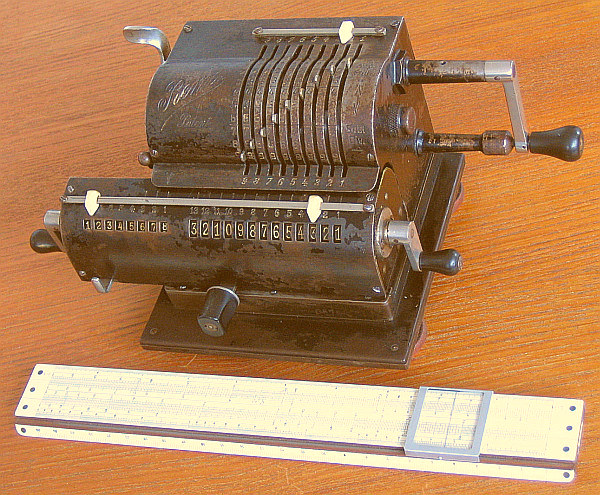previous <<==>> next
REMA
( = ACRONYM for REchenMAschine )
Have a Look Inside ...

The contemporary NESTLER No.23 (= 25 cm / 10" ) demonstrates REMA's compactness
T E C H N I C A L D A T A of the Mechanical Calculator » R E M A «
**************************************************************************
Serial Number: 6578
Dimensions: (ca.) Width = 9 " / 23 cm
Depth = 5_1/2 " / 14 cm
Height = 4_3/4 " / 12 cm
Weight: (ca.) 10 lbs / 4.5 kg
Mechanics: Pin-Wheel / Sprossenrad
10s Carry Mechanism
Counter Stepping Mechanism + Animation
Functions: Add, Subtract, Multiply, Divide
Registers: Input = 9 Decimals
Counter = 8 Decimals (NO Carry; Neg.Figures RED)
Arithmetic = 13 Decimals
Manufacturer:
Braunschweiger Rechenmaschinen Fabrik REMA GmbH
Braunschweig / Germany
1923
H O W T O U S E the R E M A
***********************************
BASIC SETTINGS:
===============
(a) Crank:
----------
For addition (+) the crank is turned clockwise; for subtraction (-) the
crank is turned counter-clockwise. In idle position the crank is down &
locked. To make one or more turns with the crank, pull out the handle
to unlock. When finished the turn(s), let the handle snap into the lock
again. The locked down position only makes other functions accessible.
REMARK: Every started turn has to be finished completely!
Accidentally started turns are correctible somehow.
(b) Clearing Registers:
-----------------------
The input unit
Pull the SILVER LEVER on the left side
The counter unit
will be cleared with the CRANK on the LEFT SIDE of the carriage
The arithmetic register
will be cleared with the CRANK on the RIGHT SIDE of the carriage
(c) Shifting the Carriage:
--------------------------
Pushing the BLACK KNOB on front to the RIGHT, will move the carriage
step-by-step to the right. The carriage can be moved continuously to
the left, when the LEFT HAND hold the carriage's left side AND the
LEFT THUMB press the little SILVER LEVER to the LEFT.
The left position "1" is the "Start Position" of the carriage.
(d) NON-Counting:
-----------------
When the little ball on the left side of the case is pushed down,
the counter is disconnected - e.g. for DIVISION Procedure ( s. below ).
ADDITION & SUBTRACTION:
=======================
Example: 123 + 45 - 6 = 162
Clear input, counter and arithmetic units.
ADD: Enter the first number (123) in the far right of the input unit.
Make a positive (clockwise) turn with the crank to transfer the number
into arithmetic unit. The counting unit displays the figure 1. Enter the
second number (45). Make a positive (clockwise) turn with the crank to
add the number. The arithmetic unit displays the intermediate sum (168)
and the counting unit displays the figure 2.
SUBTRACT: Enter the third number (6). Make a negative (counter-clockwise)
turn with the crank. The arithmetic unit displays the result (162) and
the counting unit is decreased by 1.
REMARK: NEGATIVE RESULTS are displayed in the arithmetic unit
as the COMPLEMENT of the next higher 10, 100, 1000, ...
Example: -12 = 99...9988
MULTIPLICATION:
===============
Example: 123 x 45 = 5535
Clear input, counter and arithmetic units.
Enter the multiplicand (123) in the far right of the input unit. The
multiplicator (45) has two digits, so the carriage is shifted to
position 2. Make positive (clockwise) turns with the crank, until the
first figure of the multiplicator (4) will appear in the 2nd position of
the counter unit. Shift the carriage to position 1. Repeat making positive
turns with the crank, until the second figure of the multiplicator (5)
appears in the 1st position of the counter unit. The multiplication is
done: The multiplicand (123) stays in the input unit, the multiplicator
(45) in the counter and the result (5535) is in the arithmetic unit.
DIVISION:
=========
Example: 22 : 7 = 3.1428571 Remainder 3
Division requires 3 steps:
(1st) Set the Dividend into Arithmetic Unit:
--------------------------------------------
For the maximum number of decimals, pull out the carriage to the far
right position. Enter the dividend (22) in the far right of the input
unit. Push the "NON-COUNT-LEVER" and make a positive (clockwise) turn
with the crank to transfer the divident into arithmetic unit.
(2nd) Set the Divisor into Input Unit:
--------------------------------------
Enter the divisor (7) above the dividend (22).
(3rd) Divide:
-------------
Make negative (counter-clockwise) turns with the crank until the
arithmetic unit shows an "underflow". Make one positive (clockwise)
turn with the crank. Move the carriage to the next left position.
Repeat this procedure until the required number of decimals ...
The result (3.1428571) is in the counter unit ( in RED ), and the
remainder (3) is in the arithmetic unit. The divisor (7) stays in the
input unit, therefore an additional decimal can be estimated ...
( 4, cause 4 x 7 = 28).
R E M A R K S :
---------------
The COUNTER-FIGURES ( WHITE/RED ) follows the "ODHNER-TYPE"-Scheme
Have a look at "Calculating Trickies" ...
impressum:
**************************************************************************
© C.HAMANN http://public.BHT-Berlin.de/hamann 03/04/15
|